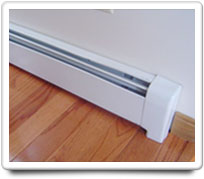Question Topic
Baseboard Heating Thawing Frozen Water Pipe

POLICY-Wizard™ calculates your ideal home care program to avoid problems with your Baseboard Heating, but sometimes trouble can still occur. Here are answers to questions about baseboard heating thawing frozen water pipe.
QUESTION FROM germil84
How to thaw frozen water pipe?
ANSWER FROM POLICY-Wizard™
Dear germil84:
The first step in thawing out the frozen water pipe in your home is to locate the main water shut-off valve for your house. It is typically locate just inside your house near where water supply first comes into your house. If you are on public water supply, then this valve will be right downstream from your water utility’s meter. Make sure you have clear access to this valve, and that it is not obstructed by boxes, storage materials, etc.
The reason you will want to locate this valve is that if during the thawing process of your frozen pipes, that the ice blockage turns out to be upstream of where the pipe has cracked, then you will want to be able to shut off your main water supply ASAP.
The next step is locating all the locations where pipes have frozen. Go around your house and open up each faucet, flush each toilet, etc. If water does not come out (or just comes out in a dribble), then you likely have a frozen pipe located in the line coming to this faucet. Even if you have found one area of frozen pipe, it is a good idea to take an additional minute to check to see if there are other areas that have been affected by the same freeze.
The next step is to try to find the specific area in your piping where the frozen blockage is occurring. Open up the faucet where you have found that water is not coming out. Follow the pipe back from the faucet to where it runs through cold areas such as an exterior wall, unheated crawl space, cabinets, or in some cases an unheated basement if the pipe is near an outside wall. Sometimes the frozen area of the pipe will be frosted or have ice on it. If the situation is getting critical the pipe may be slightly bulged or look slightly cracked.
There are two kinds of situations that you might have to deal with: 1) the frozen pipe is exposed, where you can work on it; or 2) the frozen pipe is behind a wall.
If the frozen pipe is exposed, then there are several techniques that you can use to thaw it out. We recommend that you do NOT expose your pipe to anything hotter than you would put on your hand. Heating up a pipe too fast, for example using a torch, can actually cause the pipe to rupture from the steam that is produced and is potentially trapped between frozen sections of the pipe.
A couple of good choices for heating up your frozen pipe are:
- Hair dryer.
- Hot towels (just keep replacing them as they cool off).
- Space heater.
- Light bulbs, or better yet, a heat lamp.
- Well-grounded heating pad.
On trick you can use to speed up the process is to place tin foil or a cookie sheet behind the pipe to help reflect back the heat from your hair dryer, heat lamp etc., to the back side of your pipe.
If you find that you frozen pipe is behind a wall or ceiling, then you’ve got a little different problem on your hands. But you’ve got several options here:
- Place a space heater or fan near this section of your wall or ceiling, and allow warm air to circulate around this area.
- Use lamps or better yet, heat lamps to warm up this section (keep them back at least 8-18 inches from the surface).
- Turn up the heat in your house and wait (but if its cold outside and the frozen pipe is on an outside wall and inside of a cabinet, it may be a very long wait).
Note that the techniques that we described above can be used regardless of whether you have plastic or metal pipes in your home.
Hopefully this helps you with safely thawing out your frozen pipe.
Regards,
Home-Wizard.com

 Overview
Overview Routine Care
Routine Care Q & A
Q & A Articles
Articles